The Jefferson Market Courthouse, now Library, was constructed beginning in 1875 and was inspired by Ludwig II’s Bavarian castle, Neuschwanstein. Ludwig built three magnificent castles; he later went insane and was found drowned.
The story of the Jefferson Market begins in 1833, when a large market was constructed on the new 6th Avenue in the triangle also formed by Greenwich Avenue and West 10th Street, named Jefferson Market after the former U.S. President who had died in 1826. Also in the complex were a police station, a prison, and a tall octagonal fire watch tower. Beginning in 1875, British architect Fredrick Clarke Withers built a High Victorian turreted, towered and parapet-ed Ruskinian Gothic masterpiece that served as a courthouse (with civil and police courts), with adjacent buildings along 6th Avenue serving as new housing for the market. Most notably, a 100-foot tower was built that replaced the previous one; the bell was preserved and placed in the new tower. Its spiral staircase is periodically open for visitors, as it was during Open House NY 2004.
In 1896 author Stephen Crane testified on behalf of a woman accused of prostitution in the courthouse, and in 1906, Harry K. Thaw was tried for the murder of famed architect Stanford White in the famed “Girl in the Red Velvet Swing” case. Thaw was judged insane and was sent to an asylum until released in 1915. Two years before the devastating fire in 1911 that claimed the lives of 125 workers, Triangle Shirtwaist Factory employees, mostly women, struck the company, demanding more humane conditions and higher pay. The company harassed the workers relentlessly and had dozens arrested, and cynically arranged to have their trials in this building due to its association with prostitution arrests.
By the twenties the courts in the building were used to try women exclusively. Mae West ran afoul of the ‘decency’ laws and was hauled in by the Society for the Suppression of Vice. She wound up with a $500 fine, a day at the new Women’s House of Detention, built in 1929 to replace the old market building, and a week on Welfare Island. The Women’s House of Detention had its own set of notorious names passing through, including Dorothy Day of the Catholic Workers, convicted Soviet spy Ethel Rosenberg, feminist Andrea Dworkin and radical Angela Davis. The courthouse was closed in 1971 and razed in 1973, replaced by a community garden.
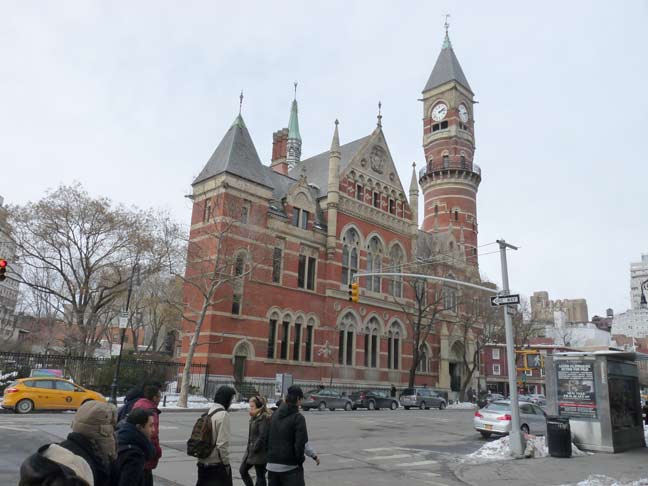
As for the Jefferson Market Building, its own courts had closed in 1945 and it was occupied only by the NYPD academy. In a familiar NYC story, by 1959 it was deteriorating, run down and a serious candidate for demolition. Village community members including architectural commentators and activists Margot Gayle and Lewis Mumford interceded …
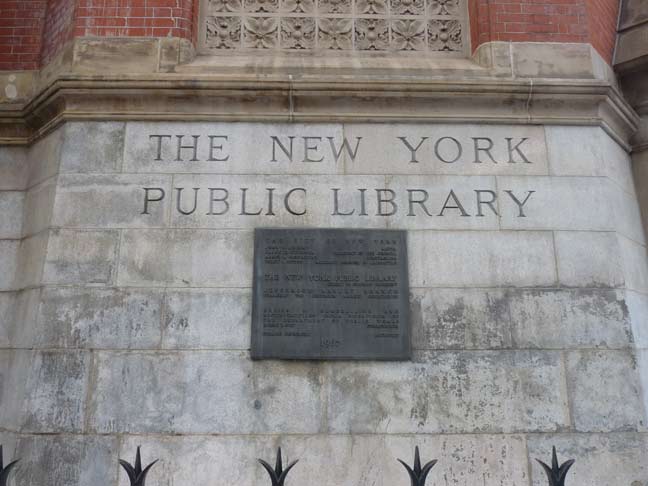
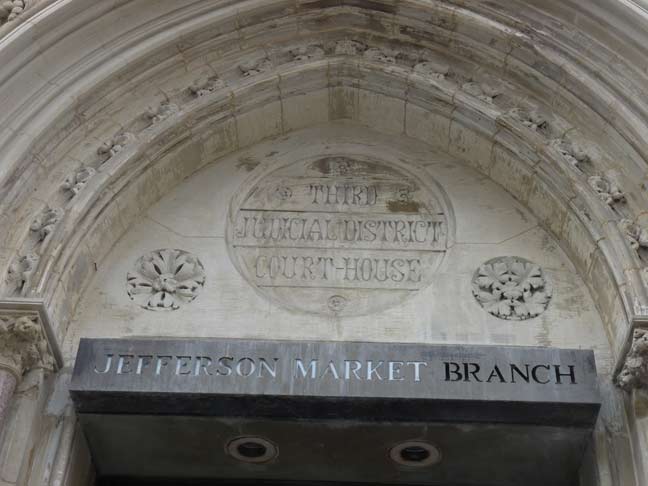
… and the decision was made, before the Landmarks Preservation Commission was organized, to save it and convert it to a library, which opened in 1967. The library is renowned for its New York city rare books collection, which I should really visit more often. My only time I was there was shortly after the ForgottenBook came out in 2006 and I gave a joint presentation with Roberta Brandes Gratz, the author of The Battle for Gotham: New York in the Shadow of Robert Moses and Jane Jacobs. Ms. Gratz is much more of an intellectual than your humble webmaster, but I held my own, and it wasn’t a debate, anyway.
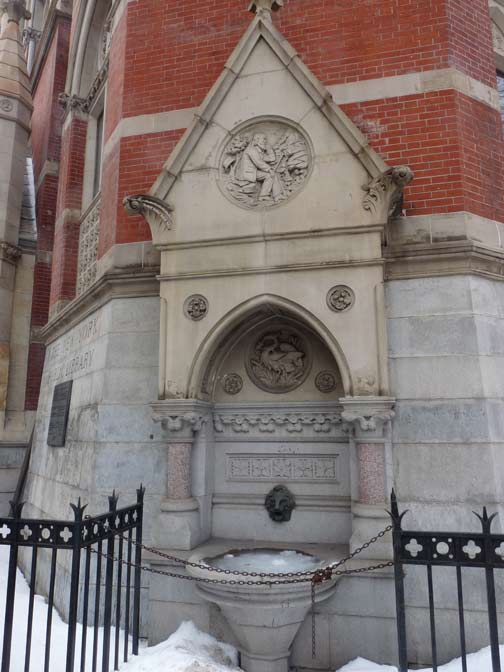
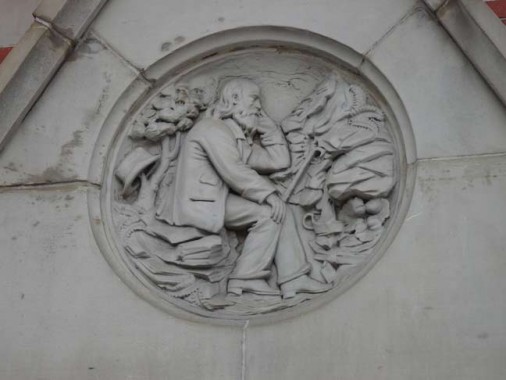
The building has so much detail for the urbanophile, like a fountain on the corner of 6th and 10th, and a bas relief of a weary traveler. I have not yet been able to determine who this fellow is, so if you know, drop me a line.
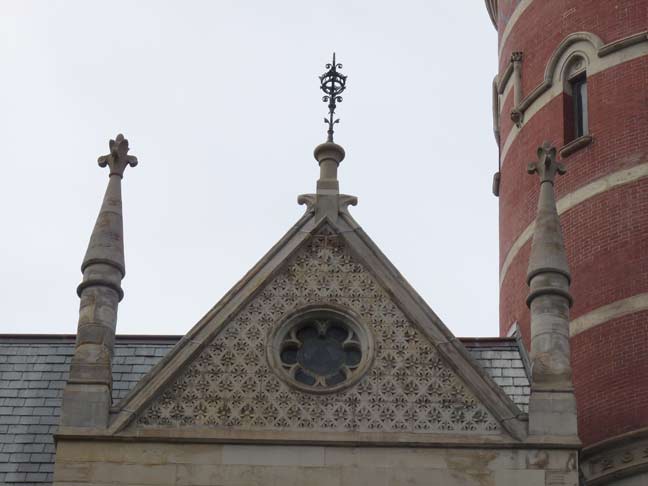
An intricately carved pediment with side columns, and a sexfoil window.
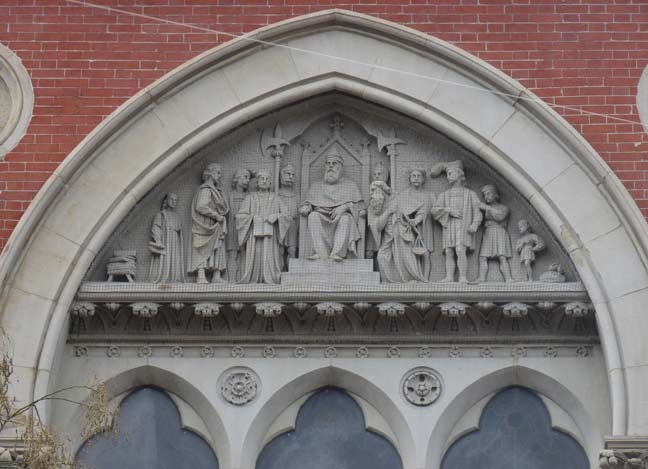
A representation of a medieval court
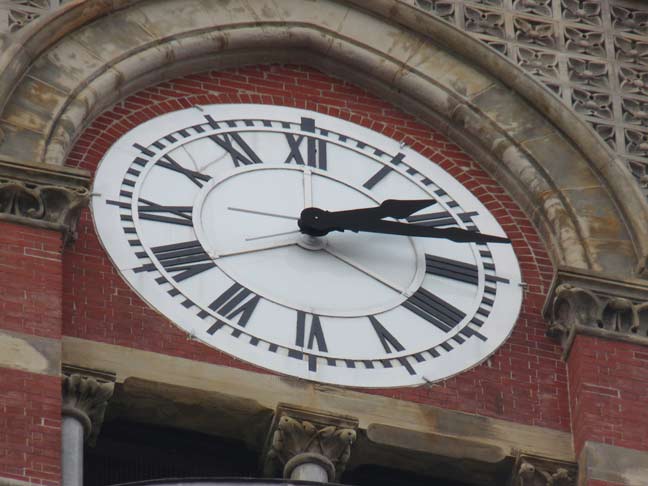
The clocks, stopped for a number of years, have recently been restarted as part of major renovations.
For more, see New York Architecture.
5/21/14


11 comments
I remember walking down Greenwich between 6th Ave and West 10th Street in the late 1960’s and seeing the men standing on the sidewalk shouting up to the “ladies” inside the WHOD. My old friend Bob Reitz owned the bookstore across from the place and he used to draw charcoal sketches of the scenes that played out between the men and their ladies.
When they raised the place I will admit I was not in sorrow.
‘raised’?
I remember the women’s jail (1930’s Stalinist Architecture ?)…passing by there you could hear the women screaming out the narrow windows.
Beautiful historic building that was thankfully saved from the wrecking ball, and placed into adaptive reuse as a library.
To the winners go the narrative!!!! The renovation of the library took so long that they closed the local library on W, 13th Street, between Greenwich and 7th Avenues, about 5 years too early, leaving the working class residents, especially kids, without a library. But it’s OK–the gentrifiers, as always, know what is best.
Also, the clock was broken off and on for years. I think I read that at least one member of the Mamas and the Papas lived on W. 10th Street, so I have always assumed that the steeple outside their window in the song “Twelve Thirty” was this courthouse steeple.
I grew up in Greenwich Village, and have many fond memories of the Jefferson Market Library. I remember my grandmother telling me that when she was a kid (in the 1920’s) the “fountain” was actually a drinking trough for horses, which were still common in the city.
Just a guess, but the “weary traveller” seems to bear a resemblance to Walt Whitman….
Excellent guess, really.
What is the indoor exploration policy? This is one of the two buildings I have always wanted to wander, the other being the Woolworth Building.
The old bridge of sighs jailhouse too, but that’s long gone.
I think the “weary traveller” might be Ruskin himself.
The tower, which still has a large bell at the top, was a lookout station for fires. When a fire was spotted, the bell was reportedly rung in a pattern to indicate the direction of the fire as an aid to firemen.
I used to work in the library occasionally, and one day, out of curiosity, I asked to go to the top of the tower. Written in chalk on the bell was the phrase, “To hell with Spain,” a relic of the Spanish American War. Can anyone confirm that this chalked imprecation still exists on the bell?